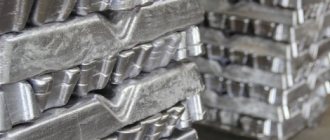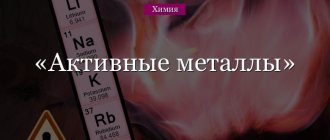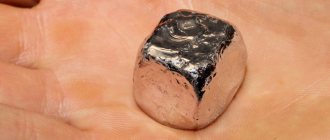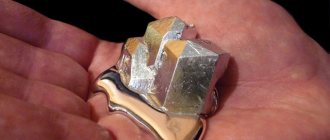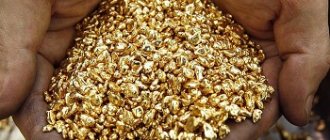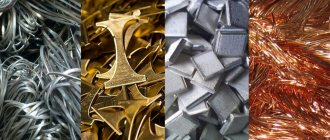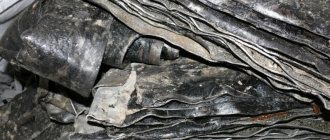Metals are a generalized name for chemical elements combined according to a number of characteristics. They occupy a large part of the periodic table, but there is still no document that allows them to be divided into classes.
Metals differ primarily in their quality characteristics. Some have high thermal conductivity, others can withstand high tensile and tensile loads. Depending on these qualities, the scope of application is determined, but metals in their natural form, even purified, do not have the necessary characteristics in sufficient form, so the technology of alloys is used, that is, the combination of several elements into one molecular lattice. This allows you to significantly improve the characteristics and give the alloy the necessary qualities.
A simple example: let’s take a common industrial alloy, bronze. This is a compound where the main element is copper. Tin is used as an alloying, that is, quality-improving, component. The result of the connection is a new metal, harder and more elastic than pure copper, which is often used to make fasteners.
Main types of classification of metals
There are several types of classification of metals. Let's start with the main type - division into two large groups: black and colored. Ferrous metals are distinguished by a high melting point, density and increased hardness. Non-ferrous metals, in most cases, melt at lower temperatures and have increased electrical and thermal conductivity.
This division is due to the distribution of elements in nature. The extraction of ferrous elements accounts for more than 90 percent of the total mass of mined metals, while the non-ferrous group accounts for no more than 5-10 percent. It should be noted that the types of classification are conditional and are used depending on the purpose of the final product that is produced from these metals. Thus, for the manufacture of fasteners, classification according to technical characteristics is used, and for the manufacture of complex alloys, chemical and crystalline. Let's look at these types in more detail.
Chemical classification of metals
All elements in the periodic table are divided into four main groups, marked with Latin letters:
- S. Marked in pink.
- P. Yellow elements.
- D. Turquoise color.
- F. Green elements in the table.
Each group contains metals. Elements from the first two categories (S and P) are called simple, and elements from groups D and F are called transitional. Also, each group is divided into several more categories. Group S includes alkali and alkali earth metals, while groups D and F include platinum, uranium and rare earth metals. At the same time, there are exceptions in each group, from which we can conclude that the division of metals into chemical groups is conventional and is rarely used in practical areas. This division is interesting only for scientific research, and is practically not applicable in industry and production. For example, the manufacture of fasteners is based on technical aspects, and only to a small extent on chemical ones.
Classification of metals by crystal lattice
All elements have a so-called crystal lattice. An abstract structure that defines the arrangement of atoms and electrons, as well as their attachment to the nucleus. In amorphous materials such as glass, the atoms are arranged randomly and do not have a strict structure. In contrast to metals, which in solid form have a strictly structured lattice, with a clear structure of molecular elements. In total, there are 4 types of crystal lattices, which are easier to present in table form:
These are the most common types of crystal lattices often found in metals. In total, the classification system has 14 configurations, but in metals they are either extremely rare or not found at all. It should also be noted that the correct construction of the lattice is possible only with the natural solidification of the metal, without artificial accelerations. If the cooling process has been accelerated, the shape of the grate will change. In production, this is called hardening, as a result of which not only the molecular structure changes, but also the technical properties.
Also, if the norms for the production of rolled metal are violated, a replacement in the crystal lattice may be observed. This leads to a complete change in the quality of the finished product. To ensure that production conditions are met, standardization standards have been developed to ensure that the finished product strictly corresponds to the technical description of its properties.
Technical classification of metals
The most complete classification system was proposed by Professor Gulyaev, although modern scientists do not agree with some of its aspects, nothing new has been proposed so far. So, ferrous metals are divided into 5 main subgroups:
- Iron metals. This includes manganese, cobalt, nickel, and of course, iron. The most common group in nature, used in alloys as the main component.
- Refractory. Elements with a high melting point. A measure of 1539 degrees Celsius was adopted as a standard.
- Rare earths. Elements that are expensive to mine and process include neodymium, europium, samarium and other metals used as additives to the base alloy. Even with a small percentage of intervention, they are capable of significantly increasing or completely changing the characteristics of the alloy.
- Alkaline. A special group, practically not used in its pure form. Most often used in nuclear energy. These include: lithium, barium, radium and others.
- Uranium. Thorium, uranium, plutonium. They are used exclusively in nuclear energy.
Non-ferrous metals are also divided into several subgroups. There are three of them:
- Lungs. Aluminum, magnesium, beryllium. They have a low specific gravity and are often used in aircraft manufacturing and other areas where a hard, but at the same time lightweight material is needed.
- Low fusible. Metals with the lowest melting point: zinc, tin, lead. They are used both in pure form, as a solder and connecting element, and as alloying additives that increase or change the characteristics of the alloy.
- Noble or precious metals. The rarest elements include: gold, silver, palladium, platinum. They have maximum resistance to corrosion and oxidation, due to which they are widely used in various industrial fields.
Almost all metals from the two groups can be mixed, that is, they can be used to produce alloys with the necessary technical characteristics.
Rhodium and platinum
Rhodium is a metal that does not have its own minerals, therefore it is one of the most expensive. You will have to pay more than $220 per gram. This noble metal has a silvery color with a bluish tint. It is distinguished by its resistance to chemical and temperature influences, but is extremely vulnerable to mechanical damage due to its fragility. Since it is quite expensive, it is used only where an analogue cannot be found.
If we consider the types and types of metals, we cannot fail to mention platinum, discovered in 1952 by a Swedish chemist. This is a fairly rare material and is found in nature only in combination of alloys with other metals. The extraction process is extremely labor-intensive and requires large investments, but it is worth it, because platinum is not affected by any acid known today. When heated, it does not change color and does not oxidize.
Classifier of metals according to GOST
If we consider brooms from the point of view of geology and distribution in nature, they are divided into two large groups: black and colored. We have already talked about this above. In chemistry, division occurs in 4 directions, but in order to bring the types of metals to a common denominator, a more precise division is necessary. Let's start with the main type of classification: metals and alloys. Metals are materials used in pure or almost pure form. Impurities are allowed here, but to an insignificant extent, that is, those that are not capable of influencing and changing the technical characteristics. Alloys are compounds with a high content of two or more elements.
In order for an alloy to receive the marking, it must contain at least 50 percent of the main component. That is, if we take bronze, we understand that more than half of its composition is copper, and the rest is divided between other metal components. Pure metals, in turn, are divided into steel and cast iron. These metals contain carbon. If its content does not exceed 2.14%, it is called steel. Above this value it is already cast iron.
Metal classification
To bring all types of metals to a single quality standard, it is necessary to divide them into groups. There are 3 such groups:
- Become,
- Cast iron,
- Alloys based on non-ferrous metals.
Each group is divided into subgroups. For steel it is:
- carbon,
- alloyed,
- special.
Carbon steel does not have alloying elements, that is, elements that change the structure. Impurities are allowed, but in small quantities. Carbon steel, in turn, is divided into tool and structural steel. The fundamental differences lie in the percentage of carbon content. Structural steel contains no more than 0.6%, and tool steel from 0.7 to 1.5%. Structural steel is further divided into regular quality and high quality. In normal quality, impurities of sulfur and phosphorus are allowed, but in an amount not exceeding 0.3 percent. Accordingly, high-quality steel does not provide for the presence of these elements in the composition, or their quantity must be less than the established norm.
Next is alloy steel, that is, a material containing a component that affects the quality characteristics of the alloy. The list of alloying elements is quite large, and it makes no sense to present it here. The alloying element content starts from 2.5%. This type of steel is called low alloy steel. If the composition is from 2.5 to 10 percent, it is already a medium-alloy grade, and when the content is over 10 percent, the result is high-alloy steel.
In addition, alloy steels are divided according to their intended purpose. There are three groups here:
- instrumental,
- structural,
- special
In standardization, each element has a letter designation, and a separate list is used to assign alloy steel to a particular class. All alloy steels are designated by a combination of letters and numbers. For example, consider the following connection: 10G2SD.
The first number here is the amount of carbon in hundredths of a percent. Next is the letter G, in the classifier meaning manganese. The number 2 following the letter G tells us that manganese is present in this composition in a two percent share. And the last two letters are additional elements whose percentage is less than 1.5%. In this case, copper and silicon are added here.
The last type of steel is special. It is divided into several groups:
- construction,
- bearing,
- reinforcement,
- boiler room,
- automatic.
Accordingly, each group has its own standards.
Next come cast irons, divided into three groups:
- white,
- bleached,
- and graphitized.
Each group also has its own divisions, but the most interesting is graphitized cast iron, which is divided into:
- grey,
- vermicular,
- malleable
- and high strength.
The relationship to any group is determined by the percentage of carbon to metal in the composition, as well as the presence of impurities allowed by standards, that is, GOSTs.
And finally, the last large group is alloys based on non-ferrous metals. There are a lot of divisions and types of classification here, so we will focus on three main categories and present them in the form of tables:
Aluminum alloys:
Copper alloys:
Alloy search in the GOST classifier
State standards clearly define not only the types of metals and alloys, but also the quality of production of blanks for further processing and production of metal products. The register is very large, and the first item we need is metals and metal products.
Next, go to the required section. Carbon and high-quality steel are marked B2 and B3, respectively, and non-ferrous metals and their alloys are in section B5. It is also worth looking in section B8, which lists foundry casting standards.
If we are talking about the manufacture of fasteners, section B5 is of greatest interest, and within it subsection B51.
We see a list of all GOSTs associated with these definitions.
It is quite large, and without knowing the specific number it is quite difficult to find the necessary article. If the number is known initially, then on the GosStandard website there is a ready-made search where you need to enter your number in order to immediately gain access to the required element.
Prospects for investment in precious metals
The most popular in our time, due to its high profitability, stability and prevalence, are investments in precious metals. Even if fiat currencies become completely worthless, an asset such as gold and silver or palladium and platinum will help to stay afloat. Their value in the investment market is constantly increasing. Large institutional investors, as well as state and commercial banks, always remain winners, despite any economic crisis, due to constant investments in precious metals and growing own gold and foreign exchange reserves.
For investments in precious metals to be most effective, it is necessary to first study the market, consider the prospects of certain metal assets, and familiarize yourself with expert forecasts. Each instrument is traded under certain conditions and assumes the presence of patterns of price volatility related to it.
Before investing significantly in any of them, for example, in gold or silver, it is necessary to assess the prospects of such investments. The main stock, currency and commodity market indices relating to oil, platinum group metals, gold and silver are today stable and consistently maintain positive values.
Areas of application of base metals
It makes no sense to consider radioactive and rare earth metals, since they practically do not take part in the production of fasteners, as well as in other areas not related to nuclear energy and some rare types of industry. We are interested in the basic metals and alloys discussed above.
Their areas of application are very diverse:
- construction,
- aircraft manufacturing,
- mechanical engineering,
- production of tools,
- metal structures,
- machine tool industry.
And so on. The manufacture of fasteners can be classified into several categories, but essentially these are metal structures, popularly called hardware. Dozens of different metals and alloys are used to produce hardware, from structural steel and cast iron to complex alloys based on titanium and copper.
Briefly about each type used for the manufacture of fasteners
Before moving on to the description of specific types of metals and alloys, it is necessary to determine what the basic technical requirements are for products that fall under the “fasteners” category. There are several of them:
- Strength takes into account tensile and fracture strength.
- Springiness. The ability of metal to return to its original shape after compression.
- Resistant to corrosion and oxidation. Relevant for all types of fasteners.
And much more. Now let's talk about specific metals and alloys. Their list is as follows:
- Aluminum and alloys based on it,
- Copper,
- Brass,
- Bronze,
- Tool steel,
- Alloy steel,
- Malleable iron,
- Stainless steel.
Let's start in order: the first point is aluminum and alloys based on it. It is used in the manufacture of rivets and various clamps. Copper can also be used in rivets to improve the quality of the hardware. In addition, special-purpose nuts are made from copper. They are used, in particular, in shipbuilding, since copper does not create a spark when in contact with other metals.
Brass and bronze are distinguished by increased strength compared to copper, therefore various dowels, anchor elements, as well as bolts, screws and screws are made from them. Another feature of these alloys is the absence of boiling. That is, during an electrical short circuit, the steel is fused, but the copper remains solid and is not destroyed.
Wing nuts, clamps and other retaining elements are made from alloy and structural steel. This is due to the high strength of these brands. Stainless steel, in turn, is used where maximum corrosion resistance is required. As for cast iron, it is most often used in the production of shut-off valves, that is, valves and locks.
Aluminum mining
This process is carried out by non-ferrous metallurgy. In terms of the scale of consumption and production, it is a leader among other heavy industries. The most common metal in the earth's crust is in great demand in the modern world. In terms of production volume, aluminum is second only to steel.
This element is most used in the aviation, automotive and electrical industries. It is noteworthy that the most common metal in the earth’s crust can also be obtained “artificially”. Such a chemical reaction would require bauxite. Alumina is formed from them. By combining this substance with carbon electrodes and fluoride salt under the influence of electric current, the purest aluminum ore can be obtained. The leading country among producers of this component is China. Up to 18.5 million tons of metal are smelted there per year. The leading company in a similar ranking for aluminum production is the Russian-Swiss association UC RUSAL.
Mercury, lead and cadmium
These are the most dangerous non-ferrous metals classified as heavy. They are major environmental pollutants. Mercury is a highly toxic metal for humans; it enters the ocean through the atmosphere and through wastewater. When power plants burn coal, mercury compounds enter the atmosphere and then fall into the ocean as precipitation. In addition, many freshwater and marine inhabitants accumulate significant amounts of mercury in their bodies, which has more than once led to human poisoning and even death.
Cadmium is a dispersed and rather rare element that enters the ocean along with wastewater from metallurgical and ore processing industries. It should be noted that cadmium is present in the human body, but it is very small. With chronic poisoning, bones are destroyed and anemia begins. As for lead, this metal is found in a dispersed state almost everywhere. These types of metals, photos of which we have given above, are excreted from the body, but rather slowly, so their excess amounts cause serious health problems. Along with continental dust, approximately 25 thousand tons of lead enter the ocean along with atmospheric precipitation.
